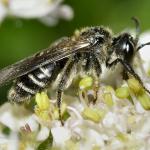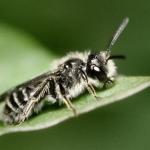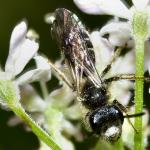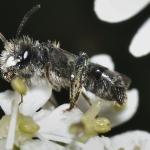Andrena shawella (Kirby, 1802).
A small, rather unobtrusive bee, the female largely black, the male with the clypeus and lower paraocular areas mainly yellow.
Found throughout Britain, the range reaching north to the North Ebudes (Skye, Eigg and Rum; also reported in the 19th Century from an unspecified site in Harris) and Orkney (Dounby on Mainland). It is present in Ireland, on the Isle of Man and in the Channel Islands (Alderney). Very local, especially in southern England (where it is quite rare). This species is predominantly found in central and northern Europe and Asia, from Fennoscandia south to Austria, and eastwards to Turkey and Siberia; also known from Japan.
This species is not regarded as being scarce or threatened.
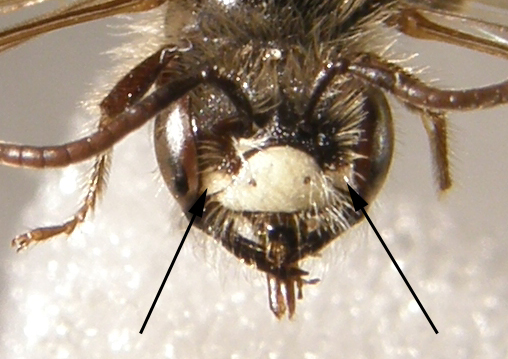
The male has a pale yellow clypeus, plus a pair of pale yellow triangular markings (arrowed) on the lower paraocular (eye margin) areas. This is a small mining bee (6-9 mm length) with entirely clear wings. (Photo: Steven Falk)
Open woodland, moorland, commons, downland, fens and coastal habitats.
Univoltine; early June to the end of August.
Nests occur solitarily. One found in deep shade in a wood was excavated below loose moss, the clay spoil being built up to form a pipe through the moss (Chambers, 1949). In Ireland, nests have been observed in dry, gravelly flats alongside rivers (Stelfox, 1927).
In addition to those listed above, these bees also visit cat’s ear (Hypocaeris radicata), common tormentil (Potentilla erecta), evening primrose (Oenothera spp.), lesser spearwort (Ranunculus flammula), lesser stitchwort (Stellaria graminea), mallow (Malva spp.), nipplewort (Lapsana communis), ragwort (Senecio spp.) and wild angelica (Angelica sylvestris).
Nomada obtusifrons Nylander is a cleptoparasite of this bee (Perkins, 1919, 1924a, 1924b; Hallett, 1928); perhaps also N. roberjeotiana Panzer (Westrich, 1989). Apparently no stylopized specimens of Andrena coitana have been reported.
2005


